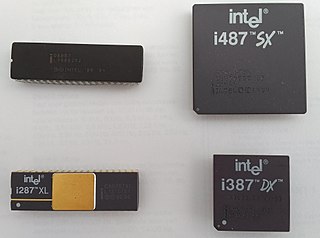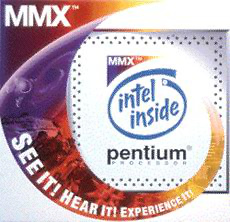
Alpha, originally known as Alpha AXP, is a 64-bit reduced instruction set computing (RISC) instruction set architecture (ISA) developed by Digital Equipment Corporation (DEC), designed to replace their 32-bit VAX complex instruction set computer (CISC) ISA. Alpha was implemented in microprocessors originally developed and fabricated by DEC. These microprocessors were most prominently used in a variety of DEC workstations and servers, which eventually formed the basis for almost all of their mid-to-upper-scale lineup. Several third-party vendors also produced Alpha systems, including PC form factor motherboards.
IA-32 is the 32-bit version of the x86 instruction set architecture, designed by Intel and first implemented in the 80386 microprocessor in 1985. IA-32 is the first incarnation of x86 that supports 32-bit computing; as a result, the "IA-32" term may be used as a metonym to refer to all x86 versions that support 32-bit computing.

A floating-point unit is a part of a computer system specially designed to carry out operations on floating point numbers. Typical operations are addition, subtraction, multiplication, division, square root, and bitshifting. Some systems can also perform various transcendental functions such as exponential or trigonometric calculations, though in most modern processors these are done with software library routines.

MMX is a single instruction, multiple data (SIMD) instruction set designed by Intel, introduced in 1997 with its P5-based Pentium line of microprocessors, designated as "Pentium with MMX Technology". It developed out of a similar unit introduced on the Intel i860, and earlier the Intel i750 video pixel processor. MMX is a processor supplementary capability that is supported on recent IA-32 processors by Intel and other vendors.
In computing, Streaming SIMD Extensions (SSE) is a single instruction, multiple data (SIMD) instruction set extension to the x86 architecture, designed by Intel and introduced in 1999 in their Pentium III series of Central processing units (CPUs) shortly after the appearance of Advanced Micro Devices (AMD's) 3DNow!. SSE contains 70 new instructions, most of which work on single precision floating point data. SIMD instructions can greatly increase performance when the exact same operations are to be performed on multiple data objects. Typical applications are digital signal processing and graphics processing.
In computer architecture, 64-bit computing is the use of processors that have datapath widths, integer size, and memory address widths of 64 bits. Also, 64-bit computer architectures for central processing units (CPUs) and arithmetic logic units (ALUs) are those that are based on processor registers, address buses, or data buses of that size. From the software perspective, 64-bit computing means the use of code with 64-bit virtual memory addresses. However, not all 64-bit instruction sets support full 64-bit virtual memory addresses; x86-64 and ARMv8, for example, support only 48 bits of virtual address, with the remaining 16 bits of the virtual address required to be all 0's or all 1's, and several 64-bit instruction sets support fewer than 64 bits of physical memory address.
3DNow! is an extension to the x86 instruction set developed by Advanced Micro Devices (AMD). It adds single instruction multiple data (SIMD) instructions to the base x86 instruction set, enabling it to perform vector processing, which improves the performance of many graphic-intensive applications. The first microprocessor to implement 3DNow was the AMD K6-2, which was introduced in 1998. When the application was appropriate this raised the speed by about 2–4 times.
x86 assembly language is a family of backward-compatible assembly languages, which provide some level of compatibility all the way back to the Intel 8008 introduced in April 1972. x86 assembly languages are used to produce object code for the x86 class of processors. Like all assembly languages, it uses short mnemonics to represent the fundamental instructions that the CPU in a computer can understand and follow. Compilers sometimes produce assembly code as an intermediate step when translating a high level program into machine code. Regarded as a programming language, assembly coding is machine-specific and low level. Assembly languages are more typically used for detailed and time critical applications such as small real-time embedded systems or operating system kernels and device drivers.

x86-64 is the 64-bit version of the x86 instruction set. It introduces two new modes of operation, 64-bit mode and compatibility mode, along with a new 4-level paging mode. With 64-bit mode and the new paging mode, it supports vastly larger amounts of virtual memory and physical memory than is possible on its 32-bit predecessors, allowing programs to store larger amounts of data in memory. x86-64 also expands general-purpose registers to 64-bit, as well extends the number of them from 8 to 16, and provides numerous other enhancements. Floating point operations are supported via mandatory SSE2-like instructions, and x87/MMX style registers are generally not used ; instead, a set of 32 vector registers, 128 bits each, is used. In 64-bit mode, instructions are modified to support 64-bit operands and 64-bit addressing mode. The compatibility mode allows 16- and 32-bit user applications to run unmodified coexisting with 64-bit applications if the 64-bit operating system supports them. As the full x86 16-bit and 32-bit instruction sets remain implemented in hardware without any intervening emulation, these older executables can run with little or no performance penalty, while newer or modified applications can take advantage of new features of the processor design to achieve performance improvements. Also, a processor supporting x86-64 still powers on in real mode for full backward compatibility.
SSE2 is one of the Intel SIMD processor supplementary instruction sets first introduced by Intel with the initial version of the Pentium 4 in 2000. It extends the earlier SSE instruction set, and is intended to fully replace MMX. Intel extended SSE2 to create SSE3 in 2004. SSE2 added 144 new instructions to SSE, which has 70 instructions. Competing chip-maker AMD added support for SSE2 with the introduction of their Opteron and Athlon 64 ranges of AMD64 64-bit CPUs in 2003.
The x86 instruction set refers to the set of instructions that x86-compatible microprocessors support. The instructions are usually part of an executable program, often stored as a computer file and executed on the processor.
The Intel BCD opcodes are a set of x86 instructions that operates with BCD numbers.
In computer processors the carry flag is a single bit in a system status register/flag register used to indicate when an arithmetic carry or borrow has been generated out of the most significant arithmetic logic unit (ALU) bit position. The carry flag enables numbers larger than a single ALU width to be added/subtracted by carrying (adding) a binary digit from a partial addition/subtraction to the least significant bit position of a more significant word. It is also used to extend bit shifts and rotates in a similar manner on many processors. For subtractive operations, two (opposite) conventions are employed as most machines set the carry flag on borrow while some machines instead reset the carry flag on borrow.

The VIA Nano is a 64-bit CPU for personal computers. The VIA Nano was released by VIA Technologies in 2008 after five years of development by its CPU division, Centaur Technology. This new Isaiah 64-bit architecture was designed from scratch, unveiled on 24 January 2008, and launched on May 29, including low-voltage variants and the Nano brand name. The processor supports a number of VIA-specific x86 extensions designed to boost efficiency in low-power appliances.
The SSE5 was a SIMD instruction set extension proposed by AMD on August 30, 2007 as a supplement to the 128-bit SSE core instructions in the AMD64 architecture.
Advanced Vector Extensions are extensions to the x86 instruction set architecture for microprocessors from Intel and AMD proposed by Intel in March 2008 and first supported by Intel with the Sandy Bridge processor shipping in Q1 2011 and later on by AMD with the Bulldozer processor shipping in Q3 2011. AVX provides new features, new instructions and a new coding scheme.
The XOP instruction set, announced by AMD on May 1, 2009, is an extension to the 128-bit SSE core instructions in the x86 and AMD64 instruction set for the Bulldozer processor core, which was released on October 12, 2011. However AMD removed support for XOP from Zen (microarchitecture) onward.
In computing, quadruple precision is a binary floating point–based computer number format that occupies 16 bytes with precision more than twice the 53-bit double precision.
AVX-512 are 512-bit extensions to the 256-bit Advanced Vector Extensions SIMD instructions for x86 instruction set architecture (ISA) proposed by Intel in July 2013, and supported in Intel's Xeon Phi x200 and Skylake-X CPUs; this includes the Core-X series, as well as the new Xeon Scalable Processor Family and Xeon D-2100 Embedded Series.






